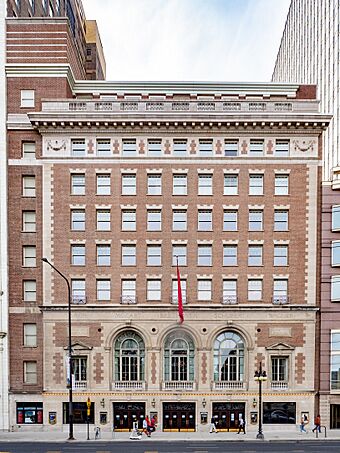Symphony Center facts for kids

Orchestra Hall (2021)
|
|
| Address | 220 S. Michigan Ave. |
|---|---|
| Location | Chicago, Illinois |
| Public transit | Adams/Wabash |
| Owner | Chicago Symphony Orchestra Association |
| Type | Concert hall |
| Capacity | Orchestra Hall: 2,522 Armour Stage: 150 Grainger Ballroom: 300 The Club at Symphony Center: 120 Buntrock Hall: 350 |
| Construction | |
| Built | 1904 |
| Opened | December 14, 1904 |
| Website | |
| Architect | Daniel Burnham |
| NRHP reference No. | 78001127 |
| Significant dates | |
| Added to NRHP | March 21, 1978 |
| Designated NHL | April 19, 1994 |
Symphony Center is a famous music building in Chicago, Illinois. It is located at 220 South Michigan Avenue in the city's downtown area, called the Loop. This amazing place is the home of the Chicago Symphony Orchestra (CSO), which is one of the best orchestras in the world!
Symphony Center is also home to the Chicago Symphony Chorus and the Civic Orchestra of Chicago. It has many different parts, including the main concert hall, Orchestra Hall, which opened in 1904. There's also Buntrock Hall, a space for rehearsals and smaller performances. You can find the beautiful Grainger Ballroom with views of Michigan Avenue and the Art Institute of Chicago. The building also has a large public area, a restaurant called Forte, and offices. In 1997, Symphony Center was completed after a big renovation and expansion project.
Contents
History of Symphony Center
Building Orchestra Hall
Orchestra Hall was built in 1904 and designed by a very famous architect named Daniel Burnham. It was specially made to be the home for the Chicago Symphony Orchestra. Before this, the orchestra played in a larger building called the Auditorium Theater.
Construction of Orchestra Hall started on May 1, 1904. The very first concert was held on December 14, 1904. The building's front has "Theodore Thomas Orchestra Hall" written on it. This honors the orchestra's first music director, who sadly passed away shortly after his first concert there. You can also see the names of famous composers like Bach, Mozart, Beethoven, Schubert, and Wagner above the ballroom windows.
More About the Building
From 1907 until 1996, a special club called the Cliff Dwellers Club was located on the ninth floor. The building also includes the historic Chapin and Gore Building, built in 1904. This building was connected to Symphony Center during the 1997 renovation.
Orchestra Hall was even used as a movie theater for a while in the 1910s. This helped the building earn money during the summer when the orchestra was playing at the Ravinia Festival. Many interesting talks and programs were also held here. Famous speakers included Harry Houdini, Richard E. Byrd, Amelia Earhart, Bertrand Russell, and Orson Welles.
In 2008, Symphony Center hosted the 2008 Green National Convention. In 2012, it was one of the places for the World Summit of Nobel Peace Laureates. This important event happened at the same time as the 2012 Chicago Summit.
Sound in Orchestra Hall
The way music sounds in Orchestra Hall has always been very important. Over the years, there have been efforts to make the sound even better. Major changes were made in the late 1960s and again between 1995 and 1997.
After the big changes in the 1990s, many people felt the sound was much improved. They noticed that the low sounds, like those from cellos and basses, had a new warmth. The overall sound became deeper and more spacious. While some high notes still needed a little adjustment, the hall sounded much better for the orchestra.
For example, one music critic wrote that the hall sounded "altogether new." Another mentioned that the "orchestra now has a mellow bass sound that simply didn't exist before." These improvements helped the music fill the hall beautifully, making concerts even more enjoyable for everyone.
See also
 In Spanish: Symphony Center (Chicago) para niños
In Spanish: Symphony Center (Chicago) para niños
- Chicago Symphony Orchestra
- List of concert halls
- Theodore Thomas



